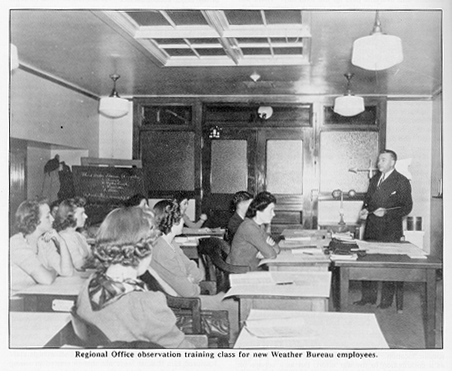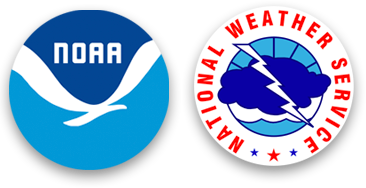Women in the Weather Bureau During WWII: Charlotte Schmidtke Jones - National Weather Service Heritage

Women in the Weather Bureau During WWII: Charlotte Schmidtke Jones
By NWS Heritage Projects Editorial StaffEditor’s Note: The following first-person account of Charlotte Schmidtke Jones first appeared in Women in the Weather Bureau During WWII by Kaye O'Brien and Gary Grice, 1991.
I worked for the Weather Bureau from March, 1943, to approximately June of 1949, with a break of approximately three months in about 1945 while attending the University of Washington. I used a different name part of the time - I married in 1949. I left in 1950, just before my first child was born, to become a full-time at-home mother.I returned to the Weather Bureau in August of 1969 and stayed until March of 1986,at which time I was eligible and took retirement at the age of sixty.
After the ten-week training session, my work stations were Sexton Summit or Sexton Mountain, Oregon; Boeing Field, Climate Office, Federal Building, Lake Union Building, and NOAA at Sand Point, (all forecast offices in Seattle). I learned that the Weather Bureau needed new employees from an article in a ladies magazine - I don't remember the name. I always found the weather fascinating and the weather people I worked with were my kind of people.
I was seventeen years old and a Senior in high school when I started with the Weather Bureau. I had very good grades. My brothers and I had a wind vane and thermometers and watched the weather regularly.
My annual salary, after the year's probation, was $1440 a year. Our training was excellent. We learned basic weather dynamics - charting - radiosonde, and PIBAL observations and aviation surface and synoptic weather observations. Wherever I worked I was welcomed and made to feel at home. My first impressions of the Weather Bureau? It was a long time ago - but the main thing I remember is how fascinating the different weather jobs were - ocean weather observers, fire weather - radiosondes and PIBALs. At that time weather observations were also vital to the growing aviation business. Morale was excellent wherever I worked - for the majority that is. There are always one or two poor sports. At Sexton Mountain my duties were hourly aviation weather observations, six-hourly synoptic observations and climate; at Boeing Field I took hourly aviation observations and six-hourly, made pilot balloon runs, plotted upper wind and radiosonde charts, and gathered climate data; at the old Federal- Building (Forecast Office to Sand Point) my duties were charting and radiosonde plotting, collecting and disseminating river data.
We lived on station at Sexton and worked mainly twelve-hour shifts. It was a three-mile hike to the road. Otherwise I worked primarily rotating shifts - days - swing and midnight. Normally I worked an eight-hour shift -except for Sexton. Weekly I worked forty hours. On a few occasions, because of illness or other emergencies, I worked two shifts - sixteen hours. The high point of my career was receiving a Bronze Medal Award. The low points were trying to do a good job while going to U. of W. and working steady graveyard shifts. When working for the Weather Bureau during World War II, primarily the senseof teamwork impressed me. There was a mutual support system and most of the men had been in the service and were pleased to have women on the staff. There were some (few), of course, who could hardly wait to see us go. Because of the caliber of women hired, there was very little (if any) backbiting, talebearing, or bad-mouthing of anyone.
Would I do Weather Bureau work again? Yes-yes-yes. I can honestly say that in my twenty-three years there were very few times that I didn't go to work with a good feeling of looking forward to fascinating weather situations. I also worked with delightful people. My contribution always was that of a woman - I never wanted to be a man. I was fully qualified technically for the job and I added the woman's touch - diplomacy, never retaliating for any reason, putting the product ahead of my ego and just doing the job. At Sexton Summit (Mountain), it was fun to see all the animals - deer, squirrels, porcupine, and skunks. Nothing is quite like shooing a skunk away from the instrument shelter or hiking up the mountain around 11 p.m. and going very carefully when you hear the rattle snakes doing their thing.
One hot day a brush fire started in the valley, jumped the highway and was about one-fourth mile from the station when it was brought under control. We were within 15-20 minutes of being evacuated. We fed the fire fighters a splendid meal and then were quite short of supplies until more could be brought up.
Another interesting night I remember being called a crumby little "bobby soxer." A young 1st Lieutenant was complaining to the forecaster that I had closed the field due to low ceiling and he couldn't take off. The forecaster backed me up all the way so the young man curled up on an unused desk and slept the night away.
